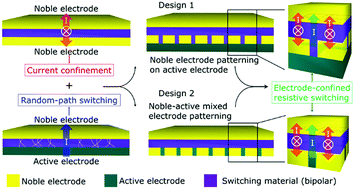Electrode-controlled confinement of conductive filaments in a nanocolumn embedded symmetric–asymmetric RRAM structure†
Abstract
Filamentary-based resistive random-access memory (RRAM) has been demonstrated to be an emerging non-volatile memory (NVM) due to high speed, high-density storage, high durability and low-power consumption. Resistive switching non-uniformity due to random formation of conductive filaments and usage of non-etchable noble metal electrodes are the two main obstacles towards the commercialization of RRAM technology. Herein, we propose a new concept of electrode-controlled confinement of conductive filaments via a novel design of a nanocolumn symmetric–asymmetric RRAM structure. Conductive filaments are confined locally in small regions of resistive switching material between asymmetric inert and active electrodes and do not form between two symmetric inert electrodes. We demonstrate the concept by utilizing Ta2O5, Fe3O4 and Ta as the resistive switching material, inert electrode and active electrode respectively and effectively confine conductive filaments within 5 nm regions. The nanocolumn RRAM design with confined conductive filaments possesses improved switching uniformity and reduced operating current, while exploiting oxide-based inert electrodes to replace noble metals in the RRAM device, presenting significant scientific and industrial value.



 Please wait while we load your content...
Please wait while we load your content...